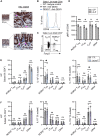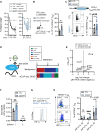RNA binding protein DDX5 restricts RORγt+ Treg suppressor function to promote intestine inflammation
- PMID: 36724232
- PMCID: PMC9891705
- DOI: 10.1126/sciadv.add6165
RNA binding protein DDX5 restricts RORγt+ Treg suppressor function to promote intestine inflammation
Abstract
Retinoid-related orphan receptor (RAR) gamma (RORγt)-expressing regulatory T cells (RORγt+ Tregs) play pivotal roles in preventing T cell hyperactivation and maintaining tissue homeostasis, in part by secreting the anti-inflammation cytokine interleukin-10 (IL-10). Here, we report that hypoxia-induced factor 1α (HIF1α) is the master transcription factor for Il10 in RORγt+ Tregs. This critical anti-inflammatory pathway is negatively regulated by an RNA binding protein DEAD box helicase 5 (DDX5). As a transcriptional corepressor, DDX5 restricts the expression of HIF1α and its downstream target gene Il10 in RORγt+ Tregs. T cell-specific Ddx5 knockout (DDX5ΔT) mice have augmented RORγt+ Treg suppressor activities and are better protected from intestinal inflammation. Genetic ablation or pharmacologic inhibition of HIF1α restores enteropathy susceptibility in DDX5ΔT mice. The DDX5-HIF1α-IL-10 pathway is conserved in mice and humans. These findings reveal potential therapeutic targets for intestinal inflammatory diseases.
Figures







References
-
- E. M. Shevach, Mechanisms of foxp3+ T regulatory cell-mediated suppression. Immunity 30, 636–645 (2009). - PubMed
-
- E. T. Clambey, E. McNamee, J. A. Westrich, L. E. Glover, E. L. Campbell, P. Jedlicka, E. F. de Zoeten, J. C. Cambier, K. R. Stenmark, S. P. Colgan, H. K. Eltzschig, Hypoxia-inducible factor-1α-dependent induction of FoxP3 drives regulatory T-cell abundance and function during inflammatory hypoxia of the mucosa. Proc. Natl. Acad. Sci. U.S.A. 109, E2784–E2793 (2012). - PMC - PubMed
MeSH terms
Substances
Grants and funding
LinkOut - more resources
Full Text Sources
Molecular Biology Databases
Research Materials

